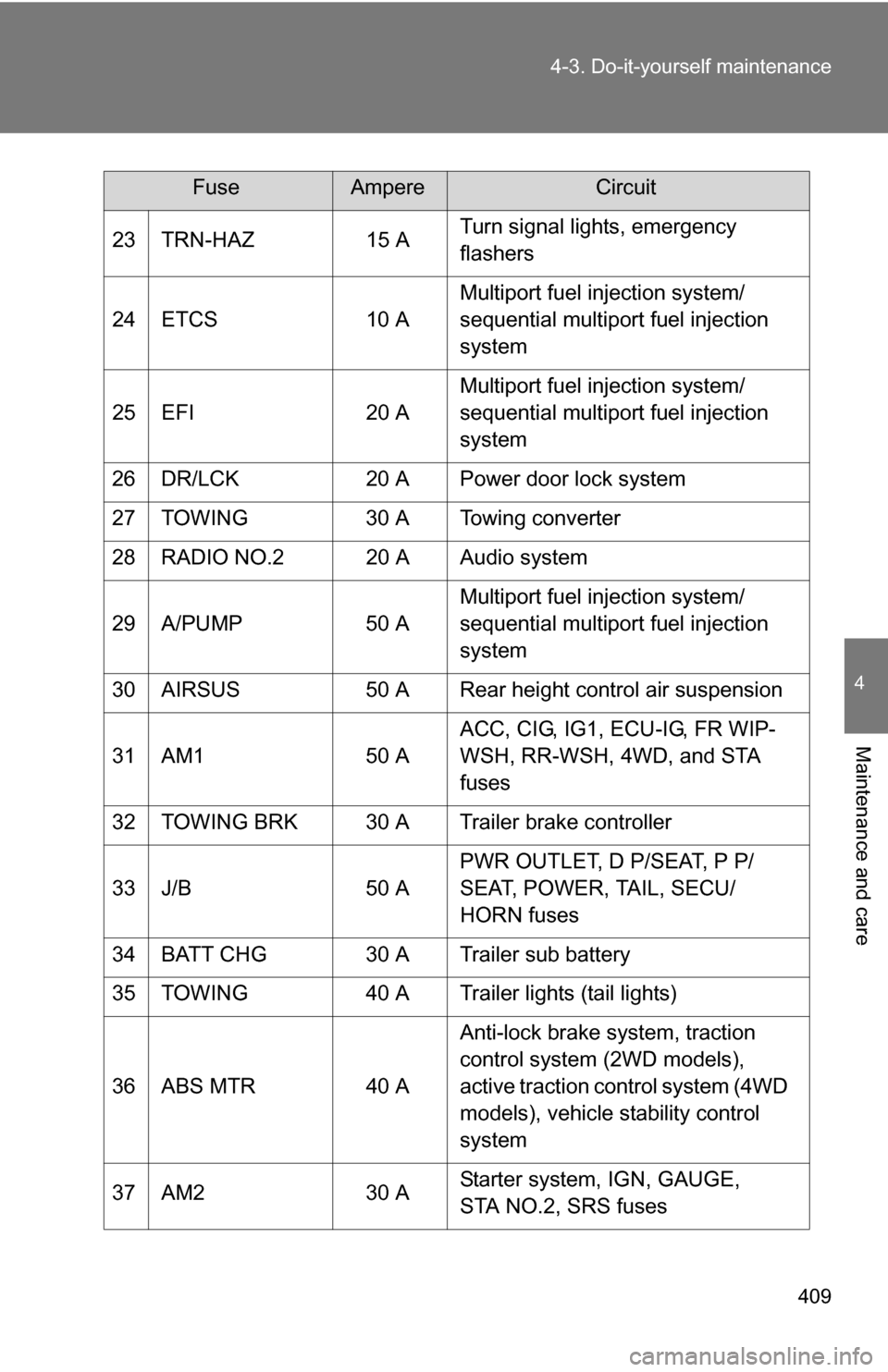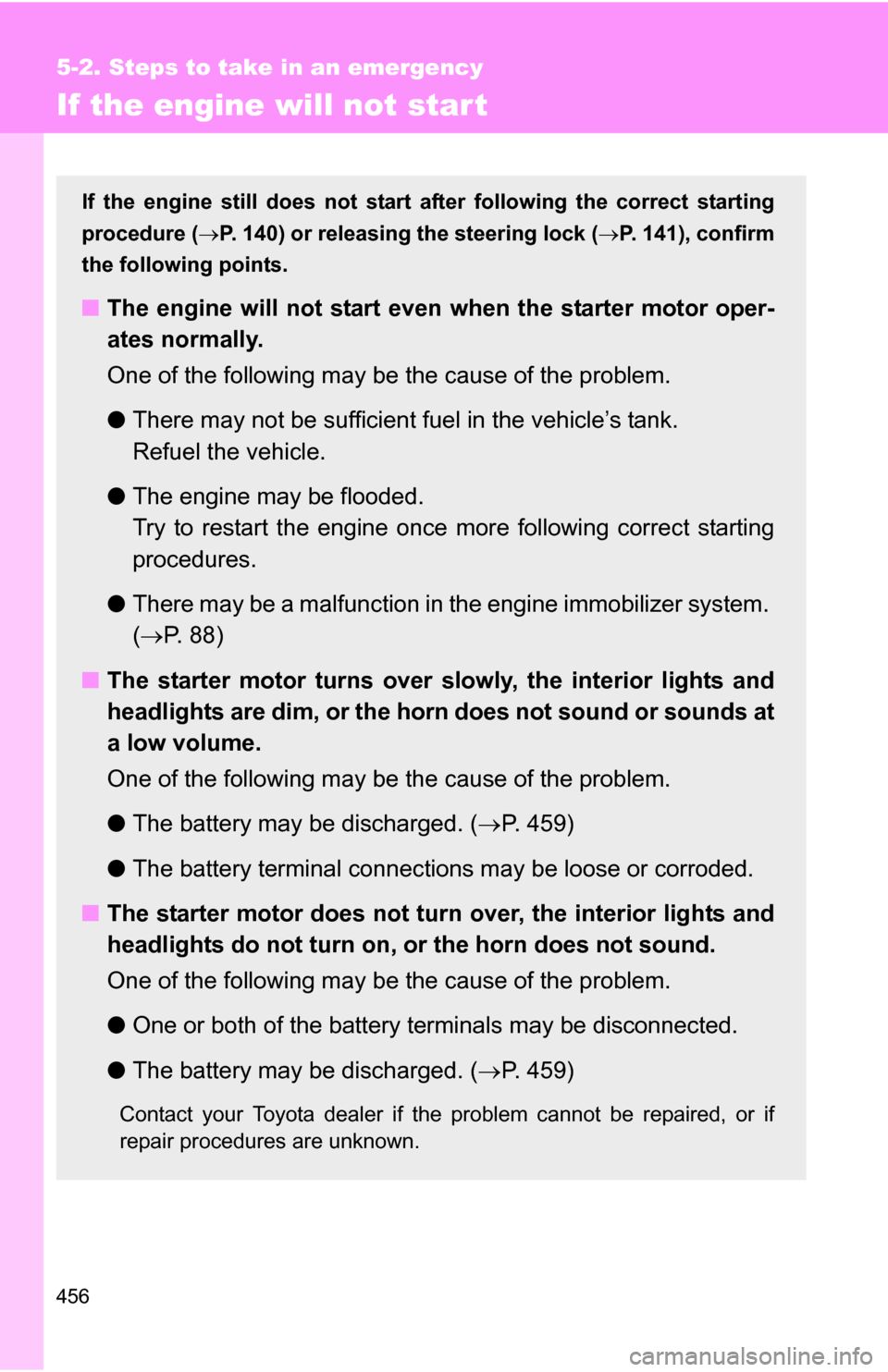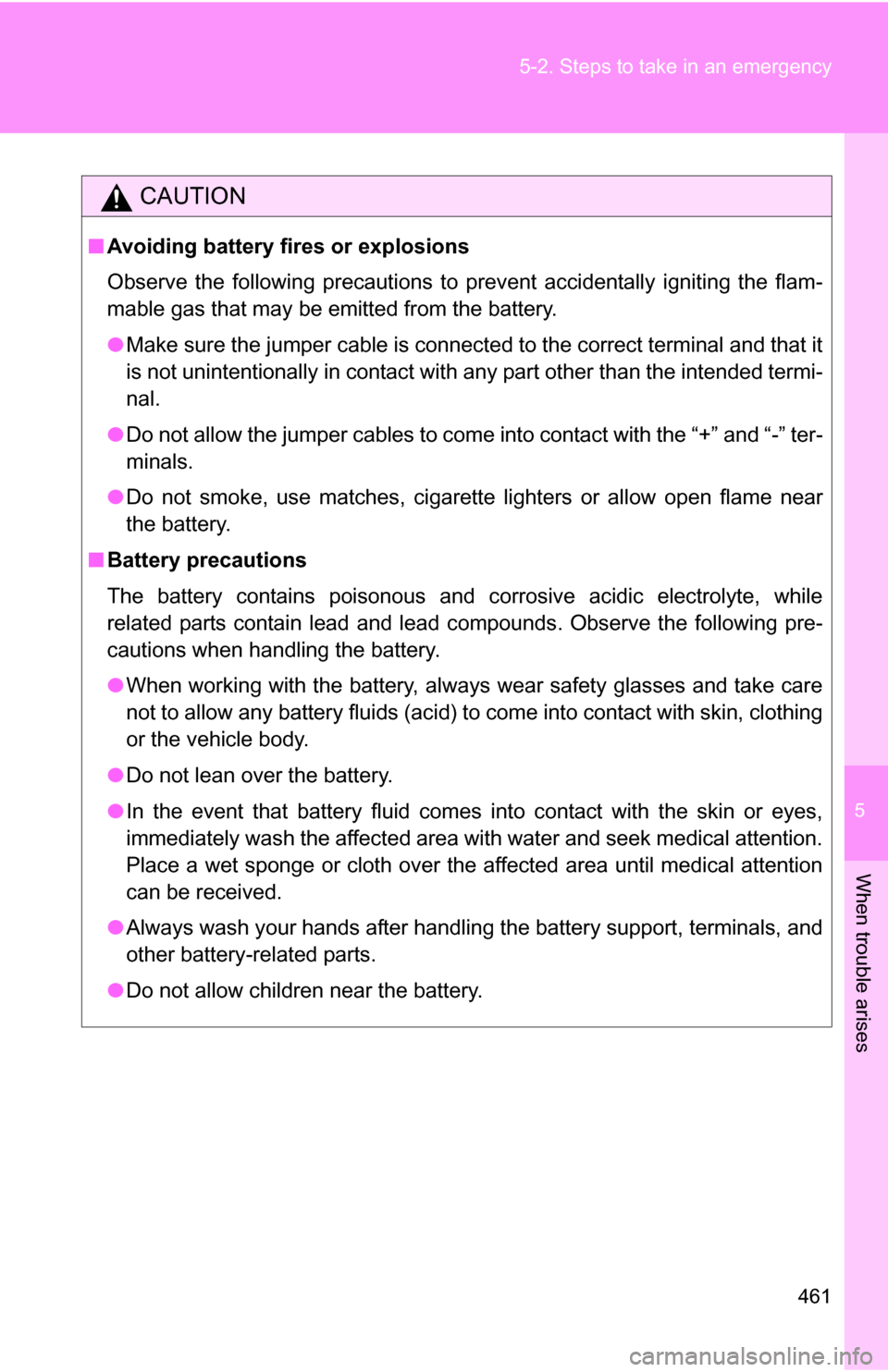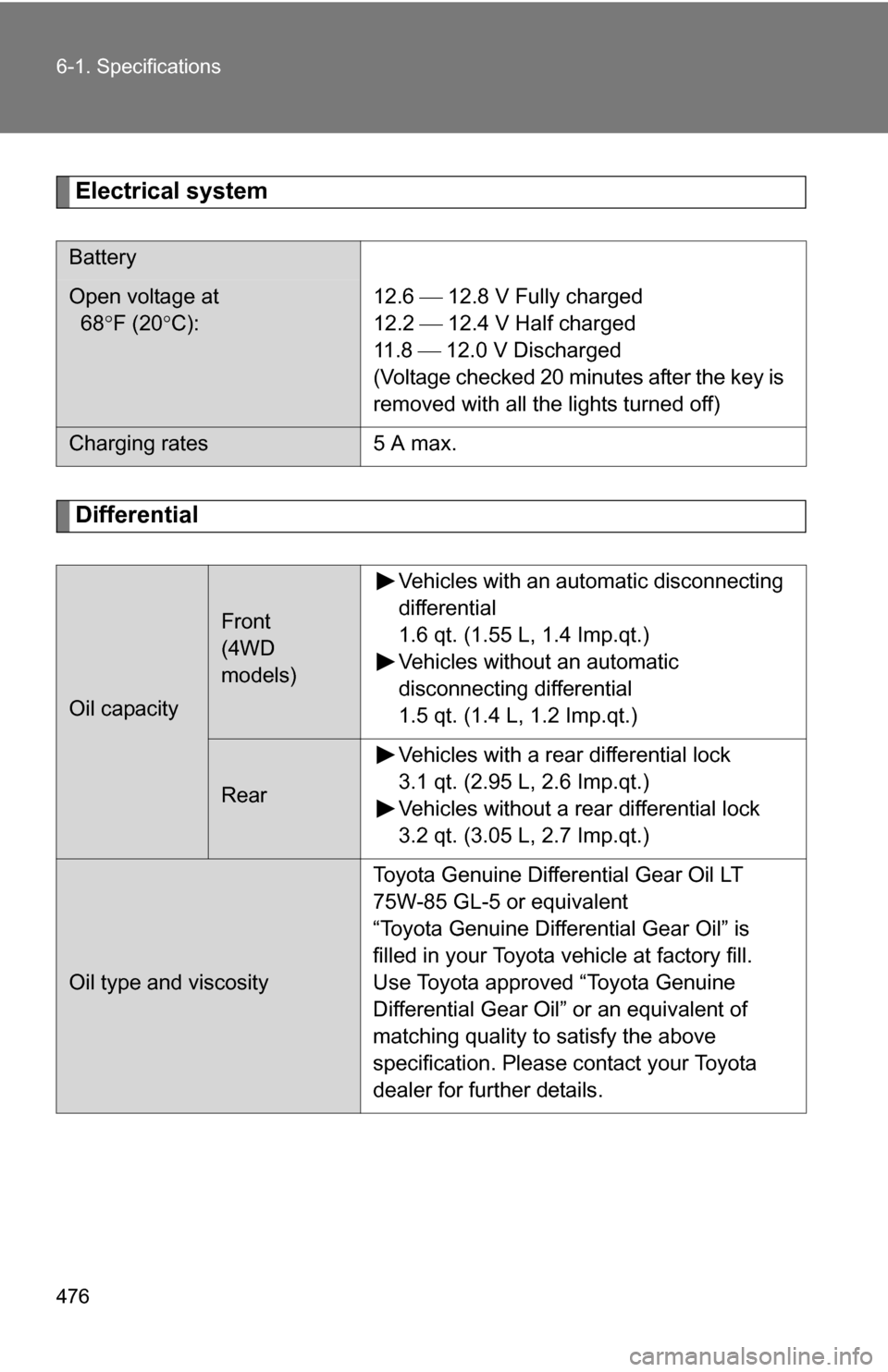Page 409 of 520

409
4-3. Do-it-yourself maintenance
4
Maintenance and care
23 TRN-HAZ
15 ATurn signal lights, emergency
flashers
24 ETCS 10 AMultiport fuel injection system/
sequential multiport fuel injection
system
25 EFI 20 AMultiport fuel injection system/
sequential multiport fuel injection
system
26 DR/LCK 20 A Power door lock system
27 TOWING 30 A Towing converter
28 RADIO NO.2 20 A Audio system
29 A/PUMP 50 AMultiport fuel injection system/
sequential multiport fuel injection
system
30 AIRSUS 50 A Rear height control air suspension
31 AM1 50 AACC, CIG, IG1, ECU-IG, FR WIP-
WSH, RR-WSH, 4WD, and STA
fuses
32 TOWING BRK 30 A Trailer brake controller
33 J/B 50 APWR OUTLET, D P/SEAT, P P/
SEAT, POWER, TAIL, SECU/
HORN fuses
34 BATT CHG 30 A Trailer sub battery
35 TOWING 40 A Trailer lights (tail lights)
36 ABS MTR 40 AAnti-lock brake system, traction
control system (2WD models),
active traction control system (4WD
models), vehicle stability control
system
37 AM2 30 AStarter system, IGN, GAUGE,
STA NO.2, SRS fuses
FuseAmpereCircuit
Page 425 of 520
When trouble arises5
425
5-1. Essential informationEmergency flashers ......... 426
If your vehicle needs to be towed ............................. 427
If you think something is wrong ............................. 432
Fuel pump shut off system ........................... 433
Event data recorder ......... 434
5-2. Steps to take in an emergency
If a warning light turns on or a warning buzzer
sounds... ........................ 436
If you have a flat tire......... 445
If the engine will not start ................................ 456
If the shift lever cannot be shifted from P................. 457
If you lose your keys ........ 458
If the vehicle battery is discharged ..................... 459
If your vehicle overheats ....................... 463
If the vehicle becomes stuck .............................. 466
Page 426 of 520
426
5-1. Essential information
Emergency flashers
NOTICE
■To prevent battery discharge
Do not leave the emergency flashers on longer than necessary when the
engine is not running.
Use the emergency flashers if th e vehicle malfunctions or is
involved in an accident.
Press the switch to flash all
the turn signal lights. To turn
them off, press the switch
once again.
Page 456 of 520

456
5-2. Steps to take in an emergency
If the engine will not star t
If the engine still does not start after following the correct starting
procedure ( P. 140) or releasing the steering lock (P. 141), confirm
the following points.
■ The engine will not start even when the starter motor oper-
ates normally.
One of the following may be the cause of the problem.
●There may not be sufficient fuel in the vehicle’s tank.
Refuel the vehicle.
● The engine may be flooded.
Try to restart the engine once more following correct starting
procedures.
● There may be a malfunction in the engine immobilizer system.
( P. 8 8 )
■ The starter motor turns over slowly, the interior lights and
headlights are dim, or the horn does not sound or sounds at
a low volume.
One of the following may be the cause of the problem.
●The battery may be discharged. ( P. 459)
● The battery terminal connec tions may be loose or corroded.
■ The starter motor does not turn over, the interior lights and
headlights do not turn on, or the horn does not sound.
One of the following may be the cause of the problem.
● One or both of the battery terminals may be disconnected.
● The battery may be discharged. ( P. 459)
Contact your Toyota dealer if the problem cannot be repaired, or if
repair procedures are unknown.
Page 459 of 520
5
When trouble arises
459
5-2. Steps to take in an emergency
If the vehicle batter y is discharged
The following procedures may be used to start the engine if the
vehicle’s battery is discharged.
You can call your Toyota dealer or qualified repair shop.
If you have a set of jumper (or boo ster) cables and a second vehi-
cle with a 12-volt battery, you can jump start your Toyota following
the steps below.
Connect the jumper cables.
4.0 L V6 (1GR-FE) engine
4.7 L V8 (2UZ-FE) engine
Page 460 of 520

460 5-2. Steps to take in an emergency
■Starting the engine when the battery is discharged
The engine cannot be started by push-starting.
■ Avoiding a discharged battery
●Turn off the headlights and the audio system while the engine is turned
off.
● Turn off any unnecessary electrical components when the vehicle is run-
ning at a low speed for an extended period, such as in heavy traffic, etc.
■ When the battery is removed or discharged
The power windows, power back window, back door and moon roof must be
initialized. ( P. 498)
Positive (+) battery terminal on your vehicle
Positive (+) battery terminal on the second vehicle
Negative (-) battery terminal on the second vehicle
Connect the jumper cable to ground on your vehicle as shown in
the illustration.
Start the engine of the second vehicle. Increase the engine
speed slightly and maintain at that level for approximately 5
minutes to recharge the battery of your vehicle.
Maintain the engine speed of the second vehicle and start
the vehicle’s engine.
Once the vehicle’s engine has started, remove the jumper
cables in the exact reverse order in which they were con-
nected.
Once the engine starts, have the vehicle checked at your Toyota
dealer as soon as possible.
Page 461 of 520

5
When trouble arises
461
5-2. Steps to take in an emergency
CAUTION
■
Avoiding battery fires or explosions
Observe the following precautions to prevent accidentally igniting the flam-
mable gas that may be emitted from the battery.
●Make sure the jumper cable is connected to the correct terminal and that it
is not unintentionally in contact with any part other than the intended termi-
nal.
● Do not allow the jumper cables to come into contact with the “+” and “-” ter-
minals.
● Do not smoke, use matches, cigarette lighters or allow open flame near
the battery.
■ Battery precautions
The battery contains poisonous and corrosive acidic electrolyte, while
related parts contain lead and lead compounds. Observe the following pre-
cautions when handling the battery.
●When working with the battery, always wear safety glasses and take care
not to allow any battery fluids (acid) to come into contact with skin, clothing
or the vehicle body.
● Do not lean over the battery.
● In the event that battery fluid comes into contact with the skin or eyes,
immediately wash the affected area with water and seek medical attention.
Place a wet sponge or cloth over the affected area until medical attention
can be received.
● Always wash your hands after handling the battery support, terminals, and
other battery-related parts.
● Do not allow children near the battery.
Page 476 of 520

476 6-1. Specifications
Electrical system
Differential
Battery
Open voltage at
68F (20 C):12.6 12.8 V Fully charged
12.2 12.4 V Half charged
11 . 8 12.0 V Discharged
(Voltage checked 20 minutes after the key is
removed with all the lights turned off)
Charging rates5 A max.
Oil capacity
Front
(4WD
models) Vehicles with an automatic disconnecting
differential
1.6 qt. (1.55 L, 1.4 Imp.qt.)
Vehicles without an automatic
disconnecting differential
1.5 qt. (1.4 L, 1.2 Imp.qt.)
Rear
Vehicles with a rear differential lock
3.1 qt. (2.95 L, 2.6 Imp.qt.)
Vehicles without a rear differential lock
3.2 qt. (3.05 L, 2.7 Imp.qt.)
Oil type and viscosity Toyota Genuine Differential Gear Oil LT
75W-85 GL-5 or equivalent
“Toyota Genuine Differential Gear Oil” is
filled in your Toyota vehicle at factory fill.
Use Toyota approved “Toyota Genuine
Differential Gear Oil” or an equivalent of
matching quality to satisfy the above
specification. Please contact your Toyota
dealer for further details.